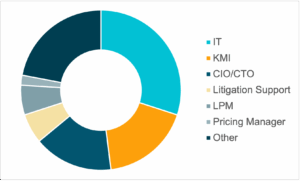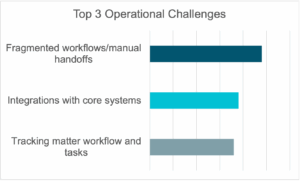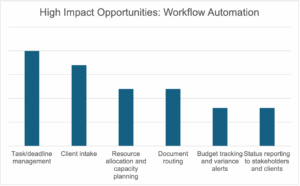At ILTACon 2025, Workstorm conducted a survey to reveal law firms’ most pressing operational challenges and areas where workflow automation could create the greatest impact within the legal industry. Participants included CIOs/CTOs, knowledge management and innovation leaders, IT professionals, litigation support, and legal project managers within medium to enterprise size law firms.

Fragmented Workflows Remain a Core Challenge
The most common operational issue reported was fragmented workflows and manual handoffs, cited by nearly half of respondents. Integration gaps with core systems and difficulties in tracking matter workflows and tasks also ranked highly. Other challenges included secure client communication, segmented reporting, and limited visibility into budgets and utilization.

Workflow Automation Seen as a Game-Changer
When asked where automation could make the biggest difference, respondents pointed to task and deadline management, client intake, resource allocation and capacity planning, and document routing. Automating budget tracking and stakeholder reporting was also viewed as valuable.

Reporting: A Persistent Pain Point
Only 4% of respondents described their reporting capabilities as complete and sufficient. The vast majority (72%) said reporting was functional but required significant manual intervention to consolidate data. Another 24% admitted their reporting environment was chaotic, with key data scattered across spreadsheets and siloed applications.
Role-Specific Findings
- CIOs/CTOs: The majority flagged fragmented workflows and task tracking as top challenges. They agreed that client intake, task management, and resource allocation automation would have the greatest impact. Every respondent in this group reported some level of reporting inefficiency, with more than a third describing it as a complete mess.
- Knowledge Management and Innovation (KMI): Two-thirds highlighted task and workflow tracking as their most pressing challenge, often tied directly to fragmented workflows. For this group, resource allocation stood out as the most impactful area for automation. Every KMI respondent confirmed their reporting requires manual intervention, with many describing it as heavily spreadsheet dependent.
- IT Professionals: This group leaned more toward client intake and document routing as high-impact automation opportunities. All agreed that reporting currently requires manual consolidation and improvement.
Shifts in Survey Demographics Since 2024
Compared to the previous year’s survey, this year saw more knowledge management and innovation leaders represented, while the number of IT respondents decreased. Participation from C-level executives remained relatively consistent.
Summary and Workstorm Alignment
The ILTACon 2025 survey underscores that law firms continue to wrestle with fragmented processes and reporting inefficiencies. At the same time, there is broad consensus that workflow automation, especially in task management, client intake, and resource allocation, offers a clear path toward improved efficiency and better alignment with client needs.
The challenges identified in the survey, mainly fragmented workflows, lack of integration, manual reporting, and capacity planning, are precisely the areas where the Workstorm platform is designed to deliver value. By centralizing communication, streamlining task and deadline management, and integrating with core legal systems, Workstorm helps eliminate manual handoffs and disconnected workflows. Its automation capabilities support client intake, document routing, and resource allocation, while its reporting tools provide real-time visibility without the need for manual consolidation. In short, Workstorm directly addresses the operational pain points highlighted at ILTACon 2025, offering law firms a practical path toward greater efficiency and collaboration.
If you’re actively exploring workflow automation and reporting options to simplify and centralize matter management, Workstorm can work with you on a solution. Let’s connect >>



